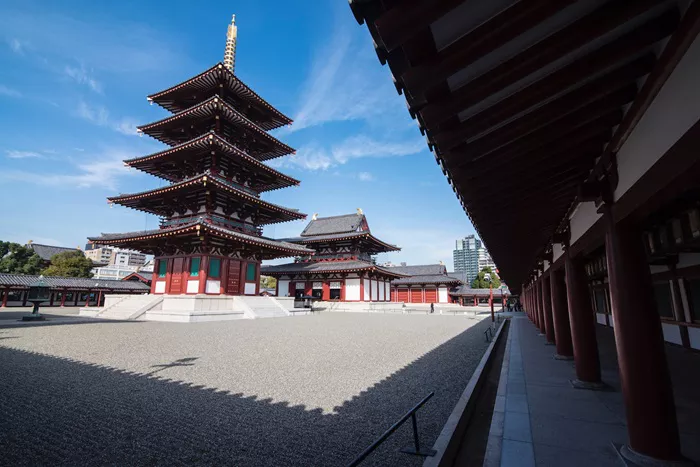Shitenno-ji is one of the oldest Buddhist temples in Japan. It is located in Osaka and is known as a very important religious and cultural site. The temple has a long history dating back to the 6th century, making it a key symbol of early Japanese Buddhism.
Founded in the year 593 by Prince Shotoku, Shitenno-ji is often called the first Buddhist temple built by the Japanese imperial family. The temple’s name means “Temple of the Four Heavenly Kings.” These Four Heavenly Kings are powerful Buddhist gods who protect the world from evil.
The Historical Background of Shitenno-ji
The Role of Prince Shotoku
Prince Shotoku was a significant figure in Japanese history. He greatly supported the introduction and spread of Buddhism in Japan. His deep faith led him to build Shitenno-ji as a place for Buddhist practice and learning.
Prince Shotoku wanted to promote peace and harmony through Buddhism. Building Shitenno-ji was part of his plan to spread Buddhist teachings and values across Japan.
Early History and Development
Shitenno-ji was built following a strict layout based on ancient Chinese Buddhist temple design. The temple served as a model for many other buddhist temples built later in Japan.
Over the centuries, Shitenno-ji faced many challenges. It was destroyed by fires and wars several times but was always rebuilt with care and respect for the original design.
The Significance of Shitenno-ji in Buddhism
The Four Heavenly Kings
The temple’s name comes from the Four Heavenly Kings, called Shitenno in Japanese. These are guardian gods who protect the four directions of the world. They symbolize strength, protection, and the power to fight evil forces.
Statues of these kings stand at the temple gates. Visitors see them as protectors who guard the sacred space of Shitenno-ji.
Buddhist Teachings at Shitenno-ji
Shitenno-ji is not just a historic site but also a place of active worship and learning. It holds regular ceremonies and teachings based on Buddhist philosophy.
The temple promotes values like compassion, mindfulness, and wisdom, which are key in Buddhism. Many visitors come here to pray, meditate, and find peace.
Temple Architecture of Shitenno-ji
Layout and Design
The layout of Shitenno-ji follows an ancient and symbolic plan. It includes a main gate, a lecture hall, a main hall, a pagoda, and a lecture hall arranged in a straight line from south to north.
This style is typical in Temple architecture influenced by Chinese models, especially the Tang dynasty.
Main Structures of Shitenno-ji
The most important buildings in the temple complex include:
- Kondo (Main Hall): The place where the main statue of Buddha is enshrined.
- Pagoda: A tall, five-storied tower symbolizing the five elements of the universe.
- Kodo (Lecture Hall): Where monks teach and study Buddhist scriptures.
- Chumon (Middle Gate): A gate leading to the inner temple grounds, often guarded by statues of the Four Heavenly Kings.
Each building is carefully designed to reflect Buddhist beliefs and provide a peaceful environment for prayer and meditation.
Buddhist Architecture and Symbolism
The design of Shitenno-ji shows key elements of buddhist architecture. The structures emphasize harmony with nature, balance, and spiritual meaning.
For example, the pagoda’s five stories represent earth, water, fire, wind, and sky. The careful symmetry of the buildings expresses order and enlightenment.
Cultural and Religious Activities at Shitenno-ji
Festivals and Ceremonies
Shitenno-ji holds many important religious events. One of the most famous is the Shitenno-ji Wasso Festival, which celebrates the temple’s long history and Buddhist culture through traditional music, dance, and reenactments.
Other ceremonies include Buddhist memorial services, prayer rituals, and seasonal celebrations tied to nature and spiritual cycles.
Education and Community Role
The temple is also a center for learning. It offers classes on Buddhist teachings, meditation workshops, and cultural activities for local people and visitors.
Shitenno-ji plays an important role in the community by promoting peace, kindness, and understanding through Buddhist practice.
Visiting Shitenno-ji Today
What to See and Do
Visitors to Shitenno-ji can explore its beautiful grounds, ancient buildings, and peaceful gardens. The temple offers a chance to experience traditional Japanese Buddhist culture up close.
Some popular activities include:
- Walking the temple grounds and admiring the architecture
- Participating in meditation sessions
- Attending special Buddhist services
- Learning about the history of Buddhism in Japan
How to Get There
Shitenno-ji is easy to reach from central Osaka by public transport. Many tourists and pilgrims visit the temple daily to enjoy its spiritual atmosphere and cultural richness.
Conclusion
Shitenno-ji is more than just an ancient building. It is a living symbol of the arrival and growth of Buddhism in Japan. Through its sacred spaces, rich history, and ongoing traditions, it offers a deep insight into Buddhist faith and Japanese culture.
Whether you are interested in religious history, Temple architecture, or simply seeking peace, Shitenno-ji provides a meaningful experience that connects the past with the present.

